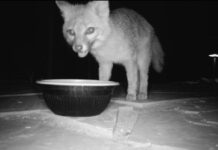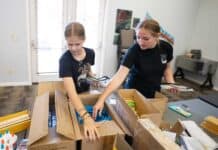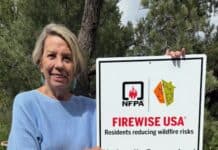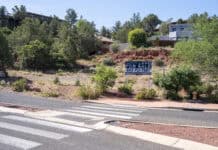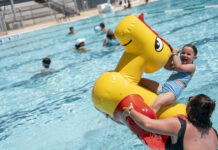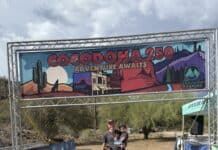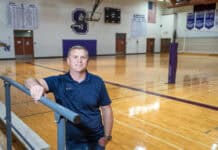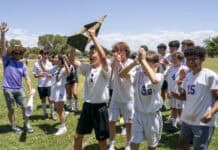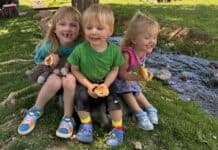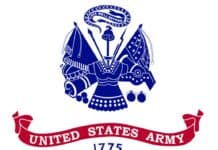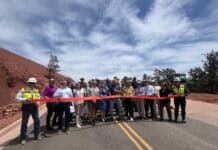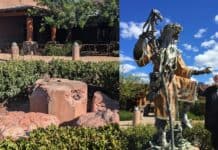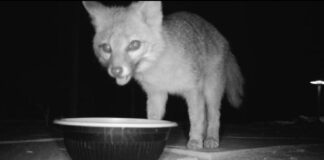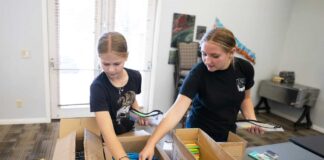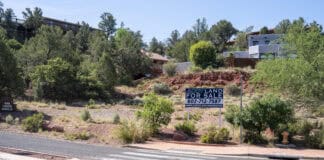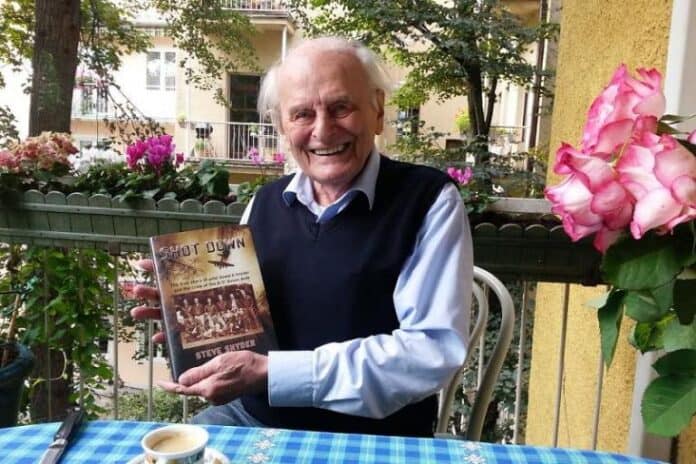
On April 13, the Sedona Heritage Museum hosted Steve Snyder, author of the 2015 book “Shot Down,” who recounted the story of the 10-man bomber crew of the B-17 “Susan Ruth,” which was piloted by his father, Howard Snyder, during World War II.
The plane crash-landed across the Franco-Belgian border during a bombing mission targeting the Frankfurt rail yards on Feb. 8, 1944.
Some of the crew of the “Susan Ruth” were killed in action, while others were captured. Howard was one of the fortunate ones to survive. He was listed as missing in action for seven months until he regrouped with the U.S. Army in Trelon, France.
“I had a very close relationship with my dad,” Snyder said. “My sisters and I always compared him to James Arness from ‘Gunsmoke.’ He was a big guy, 6-foot-2-and-a-half — he always included that half. He was a no-nonsense guy … but was a loving father and he was the coach of my Little League team and went to all my games in high school.”
After World War II, Howard Snyder became the proprietor of Snyder’s Coffee Shop in Pasadena, Calif. Howard’s wife Ruth gave birth to Steve on April 24,1947, and the family lived a short distance from the restaurant.
Howard Snyder, like most of his generation, rarely discussed his experiences during World War II. That began to change after he attended a dedication ceremony with three other members of his crew in Macquenoise, Belgium, in 1989 and was reunited with several of the people who hid him from the Nazis.

“My parents started visiting Sedona in the early ’70s and decided to retire here,” Snyder said. “They built a home in the village along what’s now the 12th fairway [at] Oakcreek Country Club and moved here in 1982. They’re founding members of Christ Lutheran Church on Chapel Road … In 2004, they needed to move into assisted living and I bought their house. They both passed away in 2007, my dad in April and my mother five months later. In a sense they’re still residents because they’re interred in the columbarium at Christ Lutheran Church.”
Snyder retired in 2009, giving him a chance to research his father’s military career, which culminated in his 2015 book “Shot Down.”
Snyder discovered two significant items among his father’s possessions from the war years. The first was an “absolutely riveting” diary that Howard wrote while he was missing in action, which has since been quoted in two other books, Gerald Astor’s “The Mighty Eighth” and Russel A. Strong’s “First Over Germany.”
“The other item that was significant were all the letters that my dad had written to my mother while he was stationed in England,” Snyder said. “He was very candid in what he wrote.”
Howard John Snyder Jr.
Snyder was born in Norfolk, Neb., on Aug. 6, 1915, and he moved with his family to California when he was 13. Howard was drafted into the Army in April 1941, and was stationed at Fort Lewis in Washington.
On leave, Howard Snyder married Ruth Hempel on July 3, 1941. By the end of 1941, Japan had bombed Pearl Harbor and the couple’s future was uncertain.
“My mother was very frightened at the time,” Snyder said. “So at Christmas, she went to Washington to visit my dad. And nine months later, Susan Ruth was born. My dad was concerned [about] how he’s going to support his new bride and baby on the way and didn’t think he could do that well on private’s pay in the infantry.”
Howard volunteered to join the Army Air Corps Aviation Training Program in June 1942, and the couple’s first child, Susan Ruth, was born on Sept. 19,1942
“I’ve been on my first mission,” Howard wrote to Ruth regarding the November 1943 strike on Wilhelmshaven, Germany. “Twenty- four more [missions] to go … It gives one an awful sickening sensation in one’s stomach to see a [Flying Fortress] go down like a great, stricken monster.”
Howard was referencing the 25-mission-limit for flyers established by Gen. Ira Eaker in 1942 that provided aircrews with hope that they could make it through the war, with the average flyer making it to six missions before being shot down.
The Eighth Mission
Howard Snyder’s eighth mission targeted Frankfurt aboard the “Susan Ruth,” named after his daughter.
“Usually it was the pilot who would name whichever airplane he was flying for a given mission,” Sedona Heritage Museum Executive Director Nate Meyers said. “We think of the Enola Gay, ‘Oh, it must have flown hundreds of missions with that name.’ It did numerous missions but only flew once as the Enola Gay, because the pilot [Col. Paul Tibbets Jr.] named it after his Mother.”
After making its bomb run, the “Susan Ruth’s” bomb bay doors were damaged by flak and the crew was unable to close them. The added drag caused them to fall behind the formation, where their B-17 was singled out by two German Focke-Wulf Fw 190 fighters. “Susan Ruth” was shot down along with both of the German fighters, one of which was piloted by Siegfried Marek, who died.
The other was flown by Hans Berger, who bailed out and survived the war.
After the crash, Howard evaded capture with the aid of Belgian freedom fighters and later joined the French White Army to carry on guerrilla warfare against the Germans.
“Unlike most airmen, he had years of experience of infantry training in the Army, so he knew how to fight on the ground, he decided to join the French Resistance,” Snyder said. “If he was captured he’d be shot on the spot as a terrorist. The safest thing probably to do would be just stay hunkered down until the U.S Army came up after D-Day to liberate the area. But he thought it was his duty to get back in the war effort.”
Hans Berger
An unlikely friendship evolved out of Snyder’s research when he developed a “special bond” with Hans Berger. Berger himself was shot down three times during the war, lost most of his friends and is the last surviving participant from the “Shot Down” story. He will be turning 99 this October.
“I felt a kind of a kinship with him because at one moment in time, my dad’s life and Hans’ life crossed paths, so he was part of my dad’s story,” Snyder said. “I never really had any ill feelings about him. If my father had died, maybe I’d feel differently. But Hans basically was just like the other U.S. airmen. He was [young], trying to do a job fighting for his country and trying to stay alive.”
Snyder typically calls Berger on his birthday, although Berger is at an age where he doesn’t answer his phone much. But Snyder said he still gets updates and vividly remembers having a gin and tonic when he visited him and read over Berger’s logbook, which described the Feb. 8 incident.
Steve Snyder’s youngest son Clayton Snyder and his wife now have a baby boy eight months old, and the couple named the child Howard Snyder. Howard’s memory lives on in his great-grandson.


